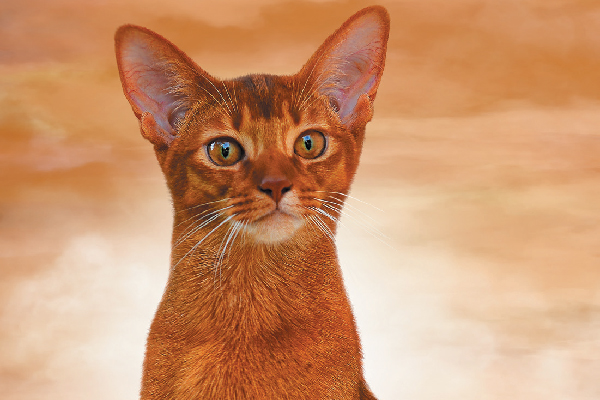In the Abyssinian alphabet, A is for active, M is for mischievous and S is for super smart. The agile and athletic cats are known for their love of heights, lively nature and unquenchable curiosity.
“Abys are very energetic, and that takes some people by surprise,” says Linda Kay Hardie, who has lived with 19 Abys over 30-plus years. “I have one Aby I got from a breeder after she got him back from the woman who had taken him. She wasn’t prepared for the energy level.”
Related: Meet Racy Mooner, an Elegant and Athletic Abyssinian Cat
With a ticked coat, large ears, wedge-shaped head and lithe but muscular body, the Aby resembles his far distant ancestor, the African wildcat (Felis lybica). Affectionate, fun loving and sociable, Abys can do well in many different types of homes with different types of people — with some caveats. Their quick movements and tendency to wend between legs can make them a hazard around people who aren’t steady on their feet, including seniors and toddlers. And they like to have company. If you’re not around during the day, an Aby will appreciate the company of another cat or a friendly dog.
“A good home is one with lots of love and attention to share with their Aby … and a love for a very athletic, high-jumping, counter-sitting, food-stealing, thrill-seeking, mischief-making, zany, lovable cat,” says Aby expert Jean Papo of Abytopia Abyssinians in Oregon.

Living with an Abyssinian Cat
- The Aby doesn’t have a reputation as a lap cat, but many owners say their cats are exceptions — at least for brief periods.
- Abys are highly trainable and amenable to walking on leash. Expect them to set the pace.
- The shorthaired Abyssinian is an easy keeper, requiring only weekly brushing to keep his sleek coat in top condition. He sheds, but not heavily.
- This entertaining cat isn’t shy about sharing his silly side, leading to the common nickname “Aby-silly-an.” Aby owner Scott Peterson says, “They’re like clowns in a European circus. They’re funny, but there’s a dignity to everything they do that you can’t miss.”
History of the Abyssinian
- A cat named Zula, brought back from Abyssinia (now Ethiopia) in 1868, was the first cat called an Abyssinian.
- Thanks to the science of DNA, we know that the ancestors of Abys likely originated along the coast of the Indian Ocean and in Southeast Asia.
- British breeders developed the Abyssinian we know and love today. The cats didn’t cross the pond to America until the early 20th century. An Aby was first exhibited in the U.S. in Boston in 1909.
- Abyssinians are the ninth most popular breed registered by the Cat Fanciers’ Association.

What you should know about the Abyssinian
- The Aby is a medium-size cat weighing 6 to 12 pounds. Abys typically reach full physical maturity by the time they are a year old.
- An Aby’s soft, silky coat has a fine texture and is described as “ticked” or “agouti”: contrasting light- and dark-colored bands on each hair shaft. The ticked coat is caused by the tabby gene, and some Abys have the well-known tabby M-shaped marking on their forehead.
- Abys come in four colors: ruddy, red (also known as sorrel), blue and fawn. Some registries also recognize the color silver. Their green or gold eyes, with dark rims, offer a striking contrast.
- The Abyssinian is generally healthy and can live to 12 to 15 years or more. Potential health problems include patellar luxation and severe gingivitis (gum disease), known as “Aby mouth.” Stringent dental care is a must for this breed.
- Marybeth Rymer, D.V.M., who has had Abys for 25 years, says genetic diseases that can affect their quality of life and shorten their years are a red blood cell disease called erythrocyte pyruvate kinase deficiency; a kidney disease called amyloidosis; and progressive retinal atrophy, which can cause blindness. “I advise potential owners to ask breeders if their cats are tested for these diseases and if they are aware of amyloidosis in their lines,” she says.
Fun Facts About the Abyssinian
- Abys are intelligent and crafty.
- If you don’t want a cat on your counters or inside your cabinets, this isn’t the cat for you.
- They’ve even been known to defeat childproof locks, Hardie says.
- Two Abyssinians starred as Jake, the feline protagonist of the 1978 film The Cat From Outer Space.
- The first cat to have her genome sequenced was an Aby named Cinnamon.
Read Next: Fall in Love With These 5 Large Cat Breeds







